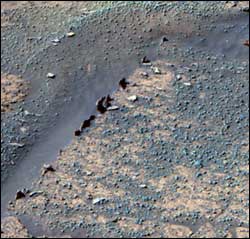Soggy Sands of Mars?

This "razorback" feature was photographed by Mars Rover Opportunity at Endurance Crater, Mars in July 2004. (NASA/JPL)
Cracks and fins in the sand in an American desert look very similar to features seen on Mars and may indicate the recent presence of water at the surface, according to a new study by researcher Greg Chavdarian and Dawn Sumner, associate professor of geology at UC Davis.
“Recent, as in ongoing now,” Sumner said.
Images from the Mars rover “Opportunity” show patterns of cracks across the surface of boulders and outcrops. Some of these cracks are associated with long, thin fins that protrude from the surface.
Those features look very similar to cracks and fins that form on the sulfate-rich sands at White Sands National Monument in New Mexico. The desert national park has a similar geological environment to the area of Mars visited by Opportunity, Sumner said.
Chavdarian spent weeks surveying the features at White Sands for an undergraduate research project. He conducted lab experiments to try and reproduce the effects. He found that the cracks at White Sands only form and grow in damp sand, especially during the wet months of the winter. In June, the sand was dry and cracks were filled in or worn away.
Cracks do form in drying mud, but this is not mud, Sumner said. There was no explanation for the formation of these types of cracks in sulfate sands before Opportunity landed, she said.
Chavdarian also looked at two types of thin, brittle fins poking a few inches out of the desert sand, usually facing into the wind. The most common type was found only in January when the sand was moist.
Chavdarian and Sumner think that the fins are formed when water seeps into cracks in the sand, carrying minerals with it. The water evaporates away, leaving behind those minerals, which are exposed as the wind blows sand away. Windblown material sticks to the exposed fin, making it larger and stronger.
If the cracks and fins seen by the Opportunity rover on Mars are formed in the same way as the features at White Sands, it would provide evidence for water at the surface of Mars away from the polar ice caps, Sumner said. Mars’ ice caps are mostly carbon dioxide with some water ice.
The research is published in the April issue of the journal Geology.
Media Contact
More Information:
http://www.ucdavis.eduAll latest news from the category: Earth Sciences
Earth Sciences (also referred to as Geosciences), which deals with basic issues surrounding our planet, plays a vital role in the area of energy and raw materials supply.
Earth Sciences comprises subjects such as geology, geography, geological informatics, paleontology, mineralogy, petrography, crystallography, geophysics, geodesy, glaciology, cartography, photogrammetry, meteorology and seismology, early-warning systems, earthquake research and polar research.
Newest articles

Combatting disruptive ‘noise’ in quantum communication
In a significant milestone for quantum communication technology, an experiment has demonstrated how networks can be leveraged to combat disruptive ‘noise’ in quantum communications. The international effort led by researchers…

Stretchable quantum dot display
Intrinsically stretchable quantum dot-based light-emitting diodes achieved record-breaking performance. A team of South Korean scientists led by Professor KIM Dae-Hyeong of the Center for Nanoparticle Research within the Institute for…

Internet can achieve quantum speed with light saved as sound
Researchers at the University of Copenhagen’s Niels Bohr Institute have developed a new way to create quantum memory: A small drum can store data sent with light in its sonic…




















